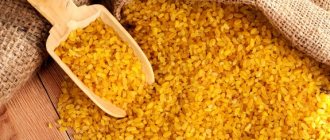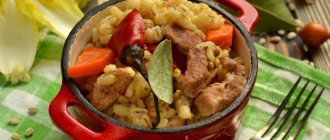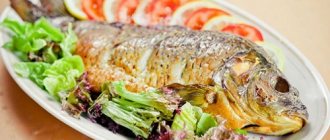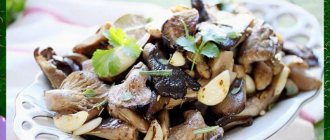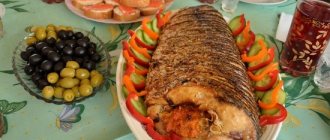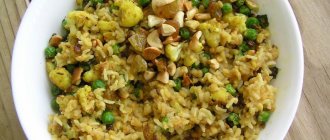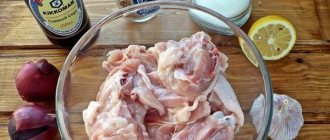Category: Main courses Published 02/18/2020 · Comments: · Reading time: 10 min · Views: 204
Greetings, dear readers of the Domovenok-Art blog! I want to tell you about one wonderful cereal that I really love. It's called bulgur . I like its taste, I like its consistency, I like how it behaves when cooked. But what is bulgur, how is it useful, what can you cook from bulgur? Favorite recipes and what is on the must do list, a short excursion into history, personal experience of use. This is what will be discussed in this article.
Make yourself comfortable. There is a lot of information, but here is the navigation through the article, read everything in a row or go to the desired section using the links ↓:
- What is bulgur;
- What are the benefits of bulgur?
- What does bulgur taste like?
- How to cook bulgur. Recipes;
- Vegetarian bulgur pilaf.
Product Description
Bulgur (burgul) is a grain with a centuries-old history.
It has been used for more than four thousand years. It is believed that it was brought to Europe from the Middle East by Maghreb merchants. Cereals are traditionally used in dishes of Mediterranean, Oriental, Indian, Armenian, Azerbaijani and Chinese cuisines. By the way, the ancient Chinese considered bulgur a sacred culture. Bulgur is a cereal obtained from durum wheat. It is subjected to heat treatment with water and drying. The grains are then hulled (polished) to remove the coarse fibrous outer shell (bran) and to produce an amber color. After which the crushing process begins. Then the cereal is sorted by degree of grinding:
- fine fraction (koftelik). Used as an additive when baking various breads, pies, muffins and cookies. This “zest” gives baked goods a delicate nutty flavor and an appetizing crunch;
- the middle fraction is ideal for preparing side dishes, cereals, thick soups, as well as snacks and desserts;
- large fraction (pilavlik) - used for preparing pilaf. The taste is not inferior to traditional rice. It successfully replaces pearl barley and couscous in recipes without boiling to a mushy state.
The calorie content of the cereal is high - 342 kcal per 100 g.
Benefit
Unfortunately, little is known about bulgur in Russia. Just a few years ago, dishes made from this grain entered restaurant menus. Many people simply underestimate the beneficial properties of porridge. Rich in iron, potassium, vitamins, folic acid and fiber, it has a beneficial effect on the cardiovascular system, helps burn fat and lower blood sugar. The complex carbohydrates contained in the cereal are absorbed slowly, without causing damage to the figure.
Harm
In some cases, bulgur can harm the body. Contraindications to eating cereals are:
- gluten intolerance;
- flatulence and frequent diarrhea;
- inflammation of the mucous membrane of the stomach and esophagus;
- increased acidity;
- tendency to overeat.
If atypical symptoms appear after consuming the product, consult a specialist. Perhaps this is a signal of a hidden problem in the body. In this case, the dish will not bring any benefit.
Benefits and harms
Bulgur contains a large number of vitamins, such as B vitamins, niacin, vitamin E, as well as trace elements such as potassium, magnesium, calcium, phosphorus, iron and copper.
This combination of useful substances makes it an extremely valuable food product that will help:
- increase stress resistance;
- reduce blood glucose levels;
- control cholesterol levels;
- improve the appearance of skin and hair;
- rid the body of waste and toxins.
At the same time, eating bulgur can have a negative effect if:
- allergies to gluten;
- peptic ulcer;
- increased stomach acidity;
- bloating and diarrhea.
Subtleties of cooking
Bulgur is used to prepare soups, main courses and desserts. Pairs well with meat, fish, seafood and vegetables. In oriental cuisine, cereals often replace traditional rice when preparing pilaf. In Cyprus, bulgur is used for traditional wedding pilaf, and in Turkey it is used to make “bride’s soup” with the addition of lentils. Cooking bulgur has its own characteristics.
- The grains are not washed or soaked. There are no exceptions to this rule.
- Before cooking, the grains are fried in butter or olive oil. This gives it a pleasant aroma and subtle nutty flavor.
- For cooking, use dishes with a thick bottom. A great option is a cauldron or wok. Over low heat, the cereal will simmer in them, but not boil.
- When cooked, the cereal increases three times. Before cooking, be sure to calculate the number of servings needed.
- The proportions of water and cereal are 1:2. This ratio is ideal for viscous porridge.
- Incompatible components. Cereals do not combine with paprika, tomato paste, tarragon and dried fruits. Do not use it with potatoes, cabbage and beets. And there are simply no recipes with eggs.
- In a multicooker, bulgur porridge is prepared in the “Buckwheat” mode. During the cooking process, the grain goes through several stages of processing, due to which the finished dish becomes crumbly.
Gourmets advise cooking bulgur in a slow cooker in several modes. First, the grain is fried in melted butter in the “Baking” mode. Fill with water and cook using the “Stew” mode. Bring to readiness in the “Warming” mode.
Simple recipe
Boiled bulgur will be a nutritious breakfast and an excellent side dish for meat or fish.
The most delicious dish will be on the first day. Do not store prepared porridge for several days. Better make it fresh. You will need:
- coarse bulgur - 1 cup;
- cold water - 2 glasses;
- butter - 2 tablespoons;
- salt - to taste.
Preparation
- Melt the butter in a cauldron.
- Add the cereal, stir, fry for 3 minutes.
- Fill with water and salt.
- Increase the heat and wait until it boils.
- Cover with a lid, reduce heat, cook for 15-20 minutes.
- Let it brew for 5 minutes.
The finished dish has a pleasant nutty taste. Serve it with butter.
Bulgur on the side
If you don't yet know how to cook bulgur as a side dish, I suggest this basic recipe. Based on it, every housewife will be able to prepare different side dishes from this cereal. You can add both vegetable and butter to the porridge, making the side dish lean or vice versa.
In addition, you can saturate the taste, aroma and color of the dish with the help of vegetables such as onions, carrots, zucchini, eggplant, broccoli and other plant products as you wish. In this case, you need to sauté the vegetables and only then add them to the finished porridge.
Original recipes
We suggest preparing a delicious sweet porridge with milk and a dish with mushrooms. The first one is suitable for breakfast, and the second one will be a good choice for dinner.
With pumpkin and apples
A hearty and incredibly appetizing dish is a good way to start the day.
It will charge you with energy and give you a feeling of fullness for several hours. You will need:
- bulgur - 1/2 cup;
- milk - 1 glass;
- pumpkin - 100 grams;
- apple - 1 piece;
- ground cinnamon - 1 gram;
- sugar - 3 teaspoons;
- water - 1 glass;
- butter - 3 tablespoons;
- dried apricots - 50 grams;
- mint - 2-3 leaves;
- salt - to taste.
Preparation
- Fry the bulgur in oil.
- Pour in water and milk.
- Peel and dice the pumpkin.
- Finely chop the dried apricots.
- Add pumpkin, dried apricots, sugar, stir, bring to a boil.
- Reduce heat, cook for 20 minutes.
- Add salt and remove from heat.
- Peel the apples and cut into cubes.
- Fry the apples in butter with added sugar for 1 minute.
- Place the porridge on a plate, add apples, and pour over the remaining syrup from frying.
- Garnish the dish with cinnamon and mint leaves.
Bulgur with milk turns out crumbly, the grains do not stick together. Pieces of pumpkin, dried apricots and caramelized apples increase the usefulness of the dish, saturating it with vitamins and microelements. Spicy notes of cinnamon and mint complete the taste.
With mushrooms
Cereals go well with mushrooms.
Even traditional champignons, which many consider tasteless, will not leave you indifferent. Try a simple recipe for bulgur porridge with mushrooms. You will need:
- bulgur - 1 cup;
- champignons - 500 grams;
- onions - 2 pieces;
- olive oil - 4 tablespoons;
- water - 2 glasses;
- parsley - 6-7 sprigs;
- salt - to taste.
Preparation
- Fry the diced onion in oil.
- Add sliced mushrooms and fry until juice forms.
- Add bulgur, fry for 5 minutes.
- Pour water, salt, simmer for 15 minutes.
- Add chopped greens.
Bulgur with mushrooms can be served with meat or used as an independent dish.
If you are on a diet or fasting, porridge will diversify your diet. We got acquainted with the basic intricacies of preparing bulgur porridge. Now you can choose the most suitable option that will give you a boost of energy and good mood!
Bulgur is a grain with a huge number of beneficial properties and is very nutritious. It is obtained by grinding bran-free and dried milk-ripe wheat grains. Bulgur contains a large amount of vitamins B, K, E, beta-carotene, phosphorus, iron, manganese, sodium, selenium, potassium, copper, zinc and other trace elements. Externally, it resembles corn grits and increases several times when cooked. This makes bulgur a very economical product that is not only healthy, but also quite affordable.
Bulgur is a cereal widespread in eastern countries, which serves as an excellent side dish for meat and fish dishes, and is combined with vegetables and fruits. Daily consumption of this cereal strengthens the nervous system and has a great effect on the condition of the skin, hair, nails, and complexion. This culture is not very widespread here, which is a pity. Our housewives hardly know how to cook bulgur deliciously. But it can be used in the preparation of cabbage rolls and stuffed peppers, replacing rice with it, and serving as a side dish instead of potatoes, pasta and cereals - this will make our dishes easier for the body to digest and healthier.
The large amount of plant fiber contained in bulgur perfectly cleanses the body and makes such side dishes indispensable in a healthy diet. And it is especially useful for the category of people who engage in heavy physical labor or sports. This is an excellent balanced product for children's diet. It, like all wheat grain porridges, can be given to children starting from 1.5 years old. However, you should not consume a large amount of this side dish - the calorie content of the product is high compared to other cereals and amounts to 342 kcal per 100 grams. product. Therefore, those who are keen on various kinds of diets consider this product to be a source of extra calories. It should be noted that just a small handful of cereal, boiled in a large amount of water, can saturate the body and satisfy the feeling of hunger for a long time.
How to cook and cook delicious bulgur
Method No. 1
To get a tasty side dish, dry cereals need to be fried with the addition of oil.
Then take 2 parts of water for one part of the cereal and cook for about a quarter of an hour, closing it tightly with a lid. Method No. 2
You can cook porridge in a thermos.
To do this, pour one part of the cereal with two parts of boiling water and leave for about 1 hour. This method is perfect if you plan to use bulgur for filling, making cutlets, and salads. Method No. 3
Place the dishes with cereal in the microwave. Don’t forget about the ability of bulgur to increase its volume by 2-2.5 times when cooked - we take dishes with this in mind. Fill with a little less water than usual and cook at maximum power for 3-4 minutes. Then, without removing the porridge from the microwave, let it brew for another 15-20 minutes.
Method No. 4
You can make a dish that tastes great in a slow cooker.
To get a crumbly side dish, you need to cook it in the “buckwheat porridge” mode, however, for true gourmets, I know a longer, but more tasty way to prepare porridge: 1. Fry the cereal in butter in the “baking” mode. 2. Add spices and salt. 3. Pour boiling water over and set to “simmer” mode for 15 minutes. 4. Then cook for another 10 minutes in “heat” mode. You and your guests will definitely love this side dish! Method No. 5
How can you cook delicious bulgur on a regular stove? Heat a frying pan, add a little oil, fry the cereal until golden brown and smell nutty, then transfer to a pan of boiling water. Make porridge, or use it for soup - this grain is suitable for everything. If you are preparing soup, after you add the fried bulgur, you need to immediately remove the soup from the stove and let it brew under the lid for 10 minutes.
After you have learned how to cook bulgur, it is worth telling what it does not taste well with, and what will enhance its taste.
Calories: Not specified
Cooking time:
Not specified
- bulgur - 1 tbsp.; - water - 2 tbsp.; - salt; – butter – 50 g.
Recipe with photos step by step:
Place a saucepan or thick-bottomed pan on the fire. Put a piece of butter (tasty) in it and heat it. Wash the bulgur thoroughly and drain excess water. Place in melted butter. Fry everything together for about one minute, stirring occasionally. The oil envelops the cereal on all sides and then the porridge will not stick together during cooking. At this stage, salt the bulgur. First boil the water separately. And when it boils, pour in the cereal in a ratio of 1:2. Bring to a boil again and reduce heat to low. Cover with a lid. And now we answer the question of how long to cook bulgur. This grain does not take long to cook. 15-20 minutes is enough. After 15 minutes, see if the liquid has evaporated, then the porridge is ready. If not, cook for another 5 minutes. The total cooking time should not be more than 20 minutes. These are the pits that should appear on the surface of the porridge. This means that the dish is completely cooked and there is no liquid in it. The cereal was cooked wonderfully. It became moderately soft, but not too much. Has a bright creamy taste. And here I recommend not saving on oil, but using the real thing. Then the porridge will turn out very tasty. Serve this dish with vegetables, meat or eggs.
Note: Bulgur can be an excellent substitute for rice, for example, for stuffing or making meatballs. If you want to get it completely, then replace the butter with vegetable oil. Boiled bulgur is used as a side dish or for making salads. You can make meatless cutlets from this product by combining the porridge with eggs, vegetables and flour. This rice substitute can be one of the ingredients for making a delicious dessert. Combining it with nuts, honey, dried fruits, syrups and other goodies gives great results. Do you know how to cook bulgur differently? Share your ideas in the comments.
Bulgur (burgul) is a grain with a centuries-old history. It has been used for more than four thousand years. It is believed that it was brought to Europe from the Middle East by Maghreb merchants. Cereals are traditionally used in dishes of Mediterranean, Oriental, Indian, Armenian, Azerbaijani and Chinese cuisines. By the way, the ancient Chinese considered bulgur a sacred culture.
Bulgur is a cereal obtained from durum wheat. It is subjected to heat treatment with water and drying. The grains are then hulled (polished) to remove the coarse fibrous outer shell (bran) and to produce an amber color. After which the crushing process begins. Then the cereal is sorted by degree of grinding:
- fine fraction (koftelik). Used as an additive when baking various breads, pies, muffins and cookies. This “zest” gives baked goods a delicate nutty flavor and an appetizing crunch;
- the middle fraction is ideal for preparing side dishes, cereals, thick soups, as well as snacks and desserts;
- large fraction (pilavlik) - used for preparing pilaf. The taste is not inferior to traditional rice. It successfully replaces pearl barley and couscous in recipes without boiling to a mushy state.
The calorie content of the cereal is high - 342 kcal per 100 g.
Benefit
Unfortunately, little is known about bulgur in Russia. Just a few years ago, dishes made from this grain entered restaurant menus. Many people simply underestimate the beneficial properties of porridge. Rich in iron, potassium, vitamins, folic acid and fiber, it has a beneficial effect on the cardiovascular system, helps burn fat and lower blood sugar. The complex carbohydrates contained in the cereal are absorbed slowly, without causing damage to the figure.
Harm
In some cases, bulgur can harm the body. Contraindications to eating cereals are:
- gluten intolerance;
- flatulence and frequent diarrhea;
- inflammation of the mucous membrane of the stomach and esophagus;
- increased acidity;
- tendency to overeat.
If atypical symptoms appear after consuming the product, consult a specialist. Perhaps this is a signal of a hidden problem in the body. In this case, the dish will not bring any benefit.
The benefits of wheat cereal
In order to understand the benefits of this porridge, it is worth considering its chemical composition. In terms of calorie content, bulgur is not much different from other cereals - it is 340 kcal for every hundred grams. It is worth paying attention to other key components.
- One hundred grams of this cereal contains 8 g of fiber .
- The amount of protein is approximately 12.5 g.
- There are a lot of carbohydrates present - 69 g, while there is just under a gram of sugars.
- The composition also contains fats, in the amount of 1.75 g, 0.2 of which are saturated.
The available microelements deserve special attention. First of all, folic acid is released, and choline, vitamin PP and many representatives of group B are also present. Finally, the composition contains copper, magnesium, phosphorus, potassium, calcium and many other substances in small quantities.
All these elements provide the benefits that bulgur contains. It is believed that regular consumption of this cereal promotes the proper functioning of the nervous system and metabolism, and it also helps hair health. Porridge is easily digested and removes toxins, and therefore is equally useful for those who want to lose weight and build muscle mass.
Subtleties of cooking
Bulgur is used to prepare soups, main courses and desserts. Pairs well with meat, fish, seafood and vegetables. In oriental cuisine, cereals often replace traditional rice when preparing pilaf. In Cyprus, bulgur is used for traditional wedding pilaf, and in Turkey it is used to make “bride’s soup” with the addition of lentils. Cooking bulgur has its own characteristics.
- The cereal is not washed or soaked. There are no exceptions to this rule.
- Before cooking, the grain is fried in butter or olive oil. This gives it a pleasant aroma and subtle nutty flavor.
- For cooking use dishes with a thick bottom. A great option is a cauldron or wok. Over low heat, the cereal will simmer in them, but not boil.
- When cooked, the cereal increases three times. Before cooking, be sure to calculate the number of servings needed.
- The proportions of water and cereal are 1:2. This ratio is ideal for viscous porridge.
- Incompatible components. Cereals do not combine with paprika, tomato paste, tarragon and dried fruits. Do not use it with potatoes, cabbage and beets. And there are simply no recipes with eggs.
- In a multicooker, bulgur porridge is prepared in the “Buckwheat” mode. During the cooking process, the grain goes through several stages of processing, due to which the finished dish becomes crumbly.
Gourmets advise cooking bulgur in a slow cooker in several modes. First, the grain is fried in melted butter in the “Baking” mode. Fill with water and cook using the “Stew” mode. Bring to readiness in the “Warming” mode.
Simple recipe
Boiled bulgur will be a nutritious breakfast and an excellent side dish for meat or fish. The most delicious dish will be on the first day. Do not store prepared porridge for several days. Better make it fresh.
You will need:
- coarse bulgur - 1 cup;
- cold water - 2 glasses;
- butter - 2 tablespoons;
- salt - to taste.
Preparation
- Melt the butter in a cauldron.
- Add the cereal, stir, fry for 3 minutes.
- Fill with water and salt.
- Increase the heat and wait until it boils.
- Cover with a lid, reduce heat, cook for 15-20 minutes.
- Let it brew for 5 minutes.
The finished dish has a pleasant nutty taste. Serve it with butter.
Bulgur with shrimps
Ingredients:
Bulgur - 300 g Shrimp - 400 g Frozen Mexican vegetable mixture - 1 pack Tomatoes in their own juice - 2 pcs. Half a head of garlic Parsley - 1 bunch Salt to taste
Cooking method
Cook the bulgur for 20 minutes. Cleaning the shrimp. Then fry the shrimp with garlic in olive oil. Add the vegetable mixture. Simmer for 10 minutes. Add spices and tomatoes. Add bulgur, stir, simmer for 5 minutes.
Before serving, do not forget to add greens. Bon appetit!
Original recipes
We suggest preparing a delicious sweet porridge with milk and a dish with mushrooms. The first one is suitable for breakfast, and the second one will be a good choice for dinner.
With pumpkin and apples
A hearty and incredibly appetizing dish is a good way to start the day. It will charge you with energy and give you a feeling of fullness for several hours.
You will need:
- bulgur - 1/2 cup;
- milk - 1 glass;
- pumpkin - 100 grams;
- apple - 1 piece;
- ground cinnamon - 1 gram;
- sugar - 3 teaspoons;
- water - 1 glass;
- butter - 3 tablespoons;
- dried apricots - 50 grams;
- mint - 2-3 leaves;
- salt - to taste.
Preparation
- Fry the bulgur in oil.
- Pour in water and milk.
- Peel and dice the pumpkin.
- Finely chop the dried apricots.
- Add pumpkin, dried apricots, sugar, stir, bring to a boil.
- Reduce heat, cook for 20 minutes.
- Add salt and remove from heat.
- Peel the apples and cut into cubes.
- Fry the apples in butter with added sugar for 1 minute.
- Place the porridge on a plate, add apples, and pour over the remaining syrup from frying.
- Garnish the dish with cinnamon and mint leaves.
Bulgur with milk turns out crumbly, the grains do not stick together. Pieces of pumpkin, dried apricots and caramelized apples increase the usefulness of the dish, saturating it with vitamins and microelements. Spicy notes of cinnamon and mint complete the taste.
With mushrooms
Cereals go well with mushrooms. Even traditional champignons, which many consider tasteless, will not leave you indifferent. Try a simple recipe for bulgur porridge with mushrooms.
You will need:
- bulgur - 1 cup;
- champignons - 500 grams;
- onions - 2 pieces;
- olive oil - 4 tablespoons;
- water - 2 glasses;
- parsley - 6-7 sprigs;
- salt - to taste.
Preparation
- Fry the diced onion in oil.
- Add sliced mushrooms and fry until juice forms.
- Add bulgur, fry for 5 minutes.
- Pour water, salt, simmer for 15 minutes.
- Add chopped greens.
Bulgur with mushrooms can be served with meat or used as an independent dish. If you are on a diet or fasting, porridge will diversify your diet.
We got acquainted with the basic intricacies of preparing bulgur porridge. Now you can choose the most suitable option that will give you a boost of energy and good mood!
Bulgur is a cereal made from durum wheat. This differs from ordinary wheat cereal in that it is made from pre-steamed or roasted grain. Wheat grains processed in this way are dried and only then crushed.
What dishes is bulgur used in?
Due to the preliminary heat treatment of the grain, the cereal has a very subtle nutty aroma - this is why housewives love it. Bulgur comes in three types: fine, medium and coarse. This difference allows you to prepare completely different dishes from it:
- The finest grains can be added to dough for bread, muffins, and cookies.
- It is recommended to prepare porridge from medium-ground bulgur.
- Large bulgur replaces rice in pilaf and is good in vegetable salads or fruit casseroles.
Bulgur, what kind of grain is it?
The product in question has been known since ancient times. Its key feature is the method of processing the grains. They are not just crushed, but first boiled until soft, then dried and peeled. Depending on the type of wheat used, the size of the fraction, color and grinding, the type of bulgur is determined.
Industrialists offer culinary experts about 12 options.
Whole grains are usually used in the preparation of pilaf; small varieties are added to dishes with meat, desserts, and soups. Nutritionists recommend the unpolished version, citing the fact that the shell contains many nutrients.
Organoleptic characteristics:
- smell – faintly nutty;
- color – all shades of yellow and light brown;
- taste – neutral.
Bulgur - how to cook
It is not recommended to wash grains called bulgur. If you think that this is contrary to the rules of cooking, then it is better to fry the cereal in a dry frying pan (4-5 minutes) or keep it in the microwave (2-3 minutes). In the second case, set the power to maximum and stir the bulgur once. Bulgur can be cooked in two ways.
In a saucepan
Pour one part of the cereal into a saucepan and fill it with two parts of hot water or broth. Add salt to taste and place the future dish on the lowest heat. Cook the bulgur covered for 10 minutes. Do not stir the cereal while cooking. To avoid burning, use a pan with a thick double bottom for cooking. Leave the finished bulgur under the lid for another 10 minutes - during this time it will completely swell.
In a thermos
Bulgur is very easy to prepare in a thermos. Put the same one part of bulgur in it and add salt to it. Pour boiling water over the cereal (2 parts) and close the lid tightly. In 5-6 hours you will have fresh steaming porridge with a nutty taste and aroma on your table. Instead of a thermos, you can use a saucepan, but then first wrap it in several layers of newspaper, and then wrap it in a warm blanket.
How to cook bulgur in soup
The cereal boils very badly, so if you do not follow the rules of proportion, you may end up with porridge instead of soup.
- Cook vegetable or meat broth.
- In two liters of liquid, boil vegetables (potatoes, carrots, onions, beans, etc.) until half cooked. Take as many of them as required by the recipe.
- 10 minutes before the dish is ready, add two level tablespoons of bulgur to the soup. To prevent it from forming a lump, stir the soup.
- Cook the bulgur soup until it is softened. Keep the stove power to a minimum.
How to cook bulgur in pilaf
- Heat 1 cup of vegetable oil in a cauldron.
- Place 500 grams of meat in oil and fry it until crusty.
- Add 300 grams of onions and 300 grams of carrots to the meat. Fry the meat and vegetables for another 15 minutes.
- Add salt, pepper and your favorite spices to vegetables and meat. Stir.
- Place one glass of the largest bulgur in the cauldron and mix it with the rest of the ingredients. Warm everything together for 5-7 minutes.
- Pour three glasses of hot water over the meat, vegetables and bulgur.
- Reduce the heat to low and cook the pilaf until all the water is absorbed into the cereal.
Bulgur makes very tasty dessert porridges. Then use milk instead of water to cook it. Separately, fry pieces of fresh fruit in butter and be sure to sprinkle them with sugar. Place the finished bulgur, cooked in milk, on a plate and place caramelized fruits on top.
Spicy vegetables with lemon bulgur
Ingredients:
140 g bulgur 2 small eggplants 1 sweet red pepper 2 tbsp. l. olive oil 2 tbsp. l. liquid honey 1 tsp. adjika juice and zest of half a lemon 5 sprigs of mint thick yogurt for serving
Cut the pepper in half and remove the seeds and stem. Cut into large pieces. Cut the eggplants in half lengthwise, and then into 2-3 pieces.
Mix honey, adjika and olive oil in a small bowl. Pour half of this mixture over the vegetables and stir. Heat a grill pan over medium heat and grill the peppers and eggplant on both sides until charred, 10 minutes.
Boil water in a saucepan and add bulgur. Add salt and cook over medium heat until tender, 10 minutes. Drain in a colander, then transfer to a large bowl. Pour the remaining spice mixture over the bulgur and add lemon juice. Grate the lemon zest on a fine grater, coarsely chop the mint leaves and also add to the bulgur, mix gently. Place the bulgur on a plate and place the fried vegetables on top. Serve with yogurt.
